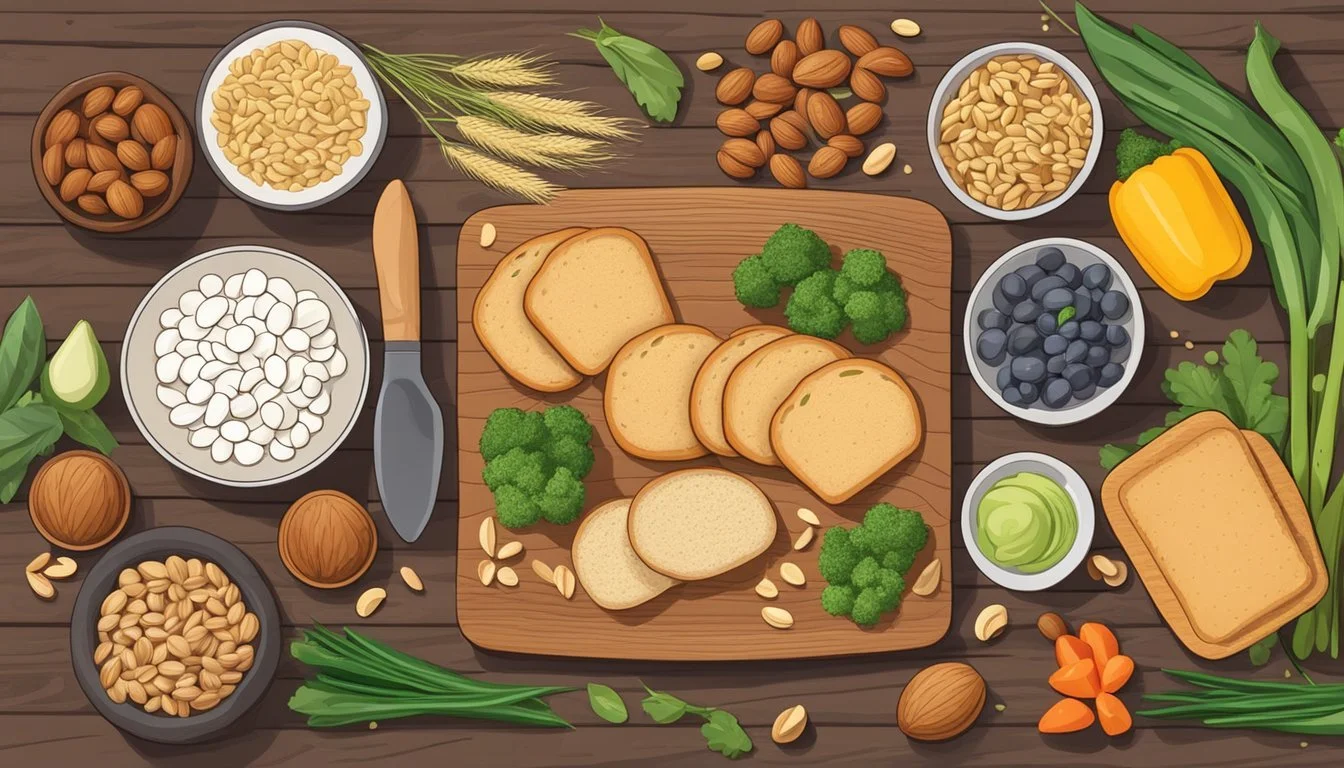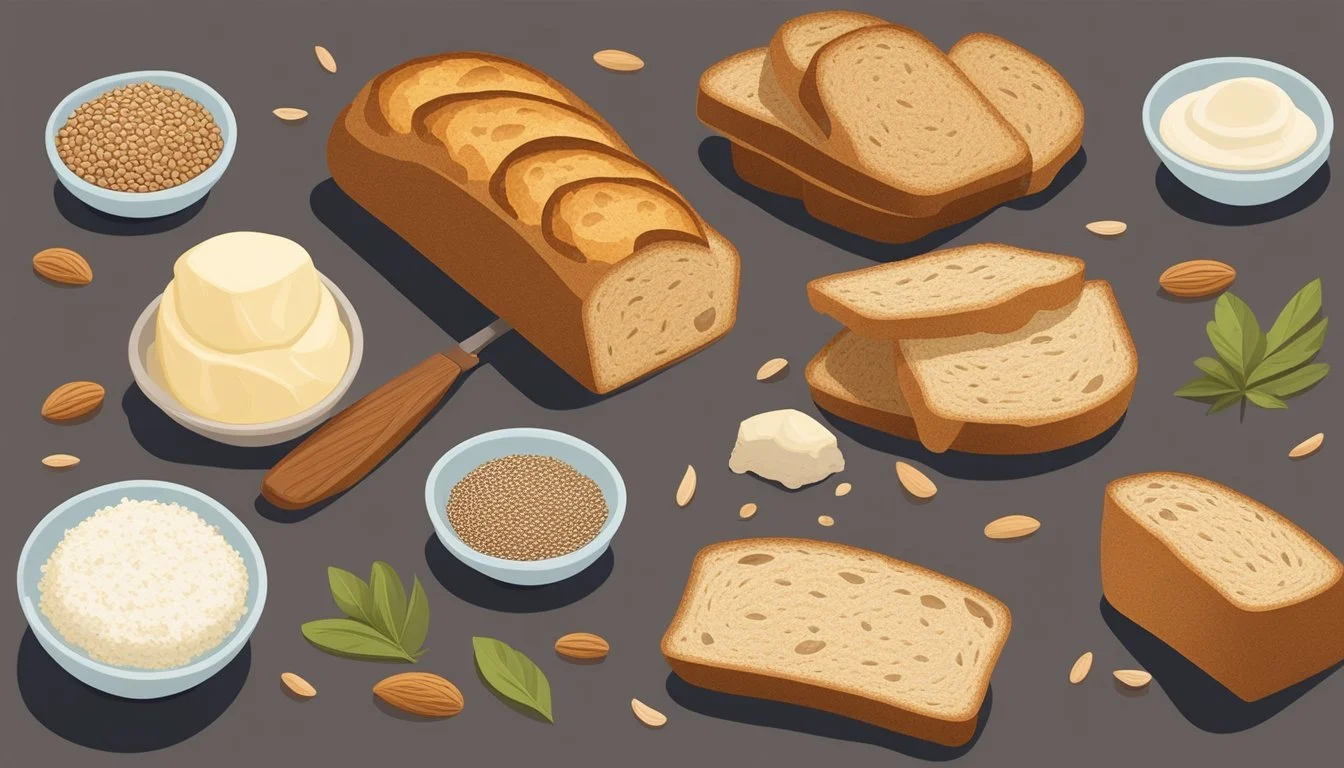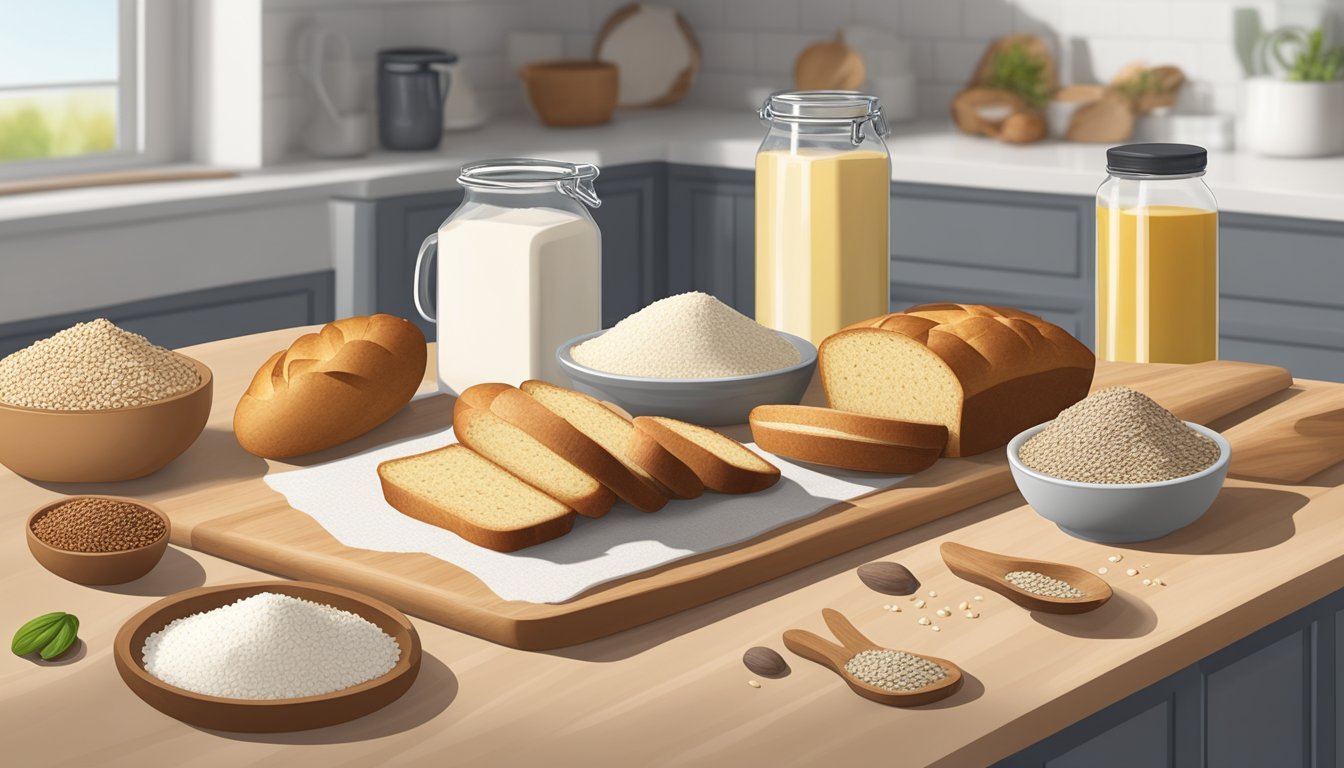6 Low-Carb Bread Alternatives for Diabetics
Healthier Choices for Better Blood Sugar Control
For those managing diabetes, finding delicious and nutritious low-carb bread alternatives can make a significant difference in maintaining stable blood sugar levels. Bread, being a staple in many diets, often poses a challenge due to its high carbohydrate content, which can lead to spikes in blood glucose.
This article explores six low-carb bread alternatives that are not only suitable for diabetics but also offer great taste and texture. These options ensure that you don't have to compromise on enjoying your favorite sandwiches or toast while keeping your blood sugar in check.
1) Cloud Bread
Cloud bread is a popular low-carb alternative to traditional bread, making it a great option for diabetics. It's made primarily from egg whites, egg yolks, and a small amount of cream cheese or other similar ingredients.
The process involves beating egg whites until stiff peaks form. This gives cloud bread its characteristic light and airy texture.
Once the egg whites are ready, they are gently folded into the other ingredients, which can include almond flour, parmesan, or baking powder, depending on the recipe.
Baking the mixture on a parchment-lined baking sheet results in small, fluffy rounds. These can be eaten plain or used as a base for sandwiches and other dishes.
Cloud bread is low in carbohydrates and has a neutral flavor, making it versatile. Some variations include adding spices or herbs to enhance the taste.
Its simplicity and ease of preparation contribute to its popularity. Many people appreciate that it can be customized easily to suit personal preferences.
2) Zucchini Bread
Zucchini bread is a versatile and nutritious alternative for those looking to reduce carb intake. It incorporates grated zucchini, which adds moisture and fiber without adding many carbohydrates. This makes it a great option for diabetics.
The preparation involves grating zucchini and removing excess water using a kitchen towel or paper towels. This step is crucial to prevent the bread from becoming too soggy.
Combining almond flour with spices such as cinnamon and nutmeg enhances the flavor while keeping the bread low-carb. Almond flour is preferred over traditional wheat flour because it has fewer carbs and a lower glycemic index.
Mixing the wet ingredients, including eggs, coconut oil, and vanilla extract, with the grated zucchini and dry ingredients forms the batter. Baking at a moderate temperature ensures the bread cooks evenly, resulting in a delicious, moist loaf that diabetics can enjoy.
This zucchini bread can serve as a snack or even a breakfast item. It is both flavorful and diabetic-friendly, making it a staple for low-carb diets. Using a sweetener instead of sugar can further reduce the carbohydrate content, making it even more suitable for those managing their blood sugar levels.
3) Almond Flour Bread
Almond flour bread is a popular low-carb option for those managing diabetes. This alternative is made primarily from almond flour, offering a dense and moist texture compared to traditional wheat bread.
Almond flour contains fewer carbohydrates, making it a suitable choice for maintaining stable blood sugar levels. It also provides healthy fats and proteins, which can further help in managing hunger and satiety.
In addition to being low in carbs, almond flour bread is gluten-free and often dairy-free. This makes it accessible to individuals with specific dietary restrictions or preferences. Its versatility allows it to be used in various recipes, from sandwiches to toast.
For those following a keto diet, almond flour bread fits well due to its high-fat content and low-carb profile. It typically requires simple ingredients such as almond flour, eggs, and baking powder, and can be made easily at home.
When toasted, almond flour bread develops a pleasant, slightly nutty flavor and a satisfying crunch. This makes it an enjoyable option for those seeking a more health-conscious bread alternative.
4) Cauliflower Bread
Cauliflower bread is an excellent low-carb alternative for diabetics who need to manage their blood sugar levels. Made primarily from riced cauliflower, this bread option provides a nutritious and delicious way to enjoy bread-like textures without the high carbohydrate content of traditional bread.
To prepare cauliflower bread, riced cauliflower is combined with almond flour, eggs, and various seasonings. This mixture forms a dough that can be baked into loaves or shaped into flatbreads, providing versatility in its use.
This type of bread is usually lighter and has a mild, slightly nutty flavor. The use of almond flour adds healthy fats and protein, which helps to keep blood sugar levels stable.
Moreover, cauliflower bread is gluten-free and can be part of a paleo or keto diet. It's a practical solution for those looking to reduce their carb intake while still wanting to enjoy the comfort of bread.
By incorporating cauliflower bread into their diet, diabetics can enjoy lower glycemic options without sacrificing taste or texture, making it easier to follow a diabetic-friendly meal plan.
5) Chia Seed Bread
Chia seed bread is an excellent low-carb alternative for diabetics. It's rich in fiber, which can help regulate blood sugar levels. The seeds themselves are packed with omega-3 fatty acids, adding nutritional value beyond just the low-carb benefits.
This type of bread typically contains around 2-4 grams of net carbs per slice, making it a very diabetic-friendly option. The high fiber content means it can keep people feeling full longer, reducing the temptation for high-carb snacks.
Chia seed bread is also versatile. It can be used for sandwiches, toasted with butter, or served as a side with meals. The mild flavor of chia seeds blends well with both savory and sweet toppings.
In addition to its nutritional benefits, chia seed bread is often gluten-free, making it suitable for individuals with gluten sensitivities. This added benefit makes it an appealing choice for those looking to maintain a gluten-free, low-carb diet.
Creating chia seed bread at home is another option. Simple recipes often include ingredients like almond flour, eggs, and baking powder, providing a straightforward way to enjoy this healthy bread alternative.
6) Eggplant Slices
Eggplant slices serve as a versatile and diabetes-friendly bread alternative. This vegetable has a low-carb profile, with only 9 grams of carbs per cup of raw eggplant. Its sturdy texture allows it to hold up well under various toppings, making it ideal for those looking to reduce carbohydrate intake.
When toasted or grilled, eggplant slices take on a slightly smoky flavor, enhancing the overall taste of the dish. They can be used as a base for pizzas, topped with tomato sauce, cheese, and other low-carb ingredients.
Eggplant also boasts significant fiber content, which aids in blood sugar regulation by slowing the digestion of carbohydrates. This feature makes it particularly beneficial for diabetics who need to monitor their glucose levels closely.
In addition to its nutritional benefits, eggplant slices can offer a satisfying, hearty bite. Whether used in sandwiches or as a replacement for toast, they provide a robust texture that mimics bread without the high carbohydrate content.
Understanding Low-Carb Diets
Low-carb diets focus on reducing carbohydrate intake and are often favored by diabetics for managing blood sugar levels. This approach can offer several health benefits and helps in maintaining a balanced intake of essential nutrients.
Benefits for Diabetics
For diabetics, low-carb diets can provide significant advantages. Blood sugar control is one of the primary benefits. By consuming fewer carbohydrates, the body requires less insulin to manage blood glucose levels.
These diets can also help with weight management, as lower carbohydrate consumption often leads to reduced calorie intake. Weight loss can improve insulin sensitivity and subsequently better blood sugar control.
Another benefit includes reduced risk of heart disease. Some studies suggest that low-carb diets may lower triglycerides and increase HDL (good) cholesterol levels, both of which are important for cardiovascular health in diabetics.
Balancing Macro and Micronutrients
While following a low-carb diet, it's essential to balance macronutrients (proteins, fats, and carbohydrates) and micronutrients (vitamins and minerals). High-quality protein sources such as lean meats, fish, eggs, and dairy should be included to maintain muscle mass and overall health.
Healthy fats like those found in avocados, nuts, seeds, and olive oil are also important. They provide energy and essential fatty acids that support brain and heart health.
Fiber is another key component. Even on a low-carb diet, consuming fiber-rich foods like vegetables and certain fruits is crucial for digestive health. Additionally, diabetics should ensure adequate intake of vitamins and minerals, which can be achieved through a balanced diet and, if necessary, supplements.
Nutritional Considerations
When considering low-carb bread alternatives for diabetics, two important factors stand out: the fiber content and the impact on blood sugar levels. These elements play crucial roles in maintaining a balanced and healthy diet for those managing diabetes.
Fiber Content in Low-Carb Alternatives
Fiber is essential for digestive health and helps regulate blood sugar levels. Low-carb bread alternatives like whole wheat tortillas and seed-based flatbreads often contain higher amounts of fiber compared to traditional bread. For example, Dave's Killer Bread Organic Thin-sliced 21 Whole Grains And Seeds Bread is noted for its high fiber content, which can aid in digestion and help maintain steady blood sugar levels.
Including fiber in the diet can improve satiety and reduce overeating. Most low-carb alternatives aim to provide at least 3 grams of fiber per serving. It’s important to read nutrition labels to ensure you're getting substantial fiber intake.
Impact on Blood Sugar Levels
Low-carb bread alternatives have varying impacts on blood sugar levels. Products like Ezekiel 4:9 Flax Sprouted Whole-Grain Bread are designed to minimize blood glucose spikes due to their lower carbohydrate content. This type of bread typically contains around 15 grams of carbs per slice, with a portion of those being dietary fiber, which doesn't spike blood sugar.
Choosing breads with a low glycemic index (GI) can further help manage blood sugar. Options like Kiss My Keto Golden Wheat are formulated to have a minimal effect on glucose levels, providing a safer alternative for diabetics. Monitoring blood sugar response after consuming these alternatives is key to understanding how they fit into your personal dietary needs.
Recipes and Preparation Tips
Discover how to make and store low-carb bread alternatives with easy recipes and practical tips. Learn creative ways to enhance your meals while keeping them diabetic-friendly.
How to Store and Use Low-Carb Breads
Proper storage is essential for maintaining the freshness of low-carb breads. Most of these alternatives do well when kept in an airtight container at room temperature for 3-4 days. For longer storage, freezing is recommended. Slices can be frozen individually, making for easy thawing and toasting when needed.
When using low-carb breads, consider the specific recipe. For example, whole wheat tortillas can be used to make wraps or as a base for mini-pizzas. Keto bread remains versatile for sandwiches or toasted with toppings. Properly stored, these breads retain texture and taste, ensuring they meet dietary requirements without sacrificing enjoyment.
Creative Recipe Ideas
Bring variety to your diet with creative low-carb bread recipes. Stuffed bell peppers using whole wheat tortillas as a lining add a satisfying crunch. Keto garlic bread pairs well with low-carb pasta dishes and salads, offering robust flavors without the high carb content.
Zucchini bread is another option, using almond flour to create a tasty, moist loaf that's perfect for breakfast or snacks. For a sweet treat, applesauce cinnamon bread can be made using whole wheat flour and natural sweeteners, offering a healthier dessert option.
Experimenting with these ideas not only enhances meal enjoyment but also ensures dietary goals are met, providing variety and nutrition in every bite.







